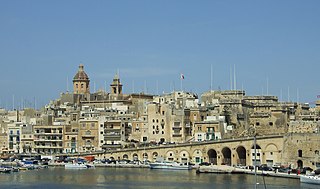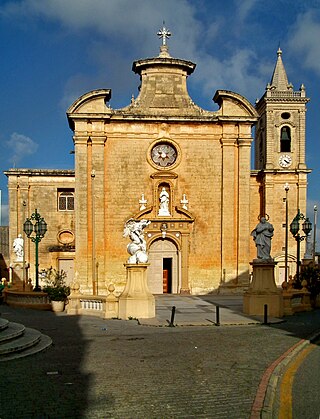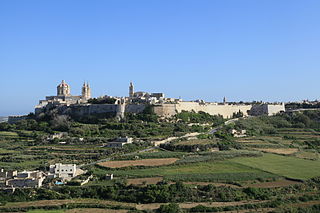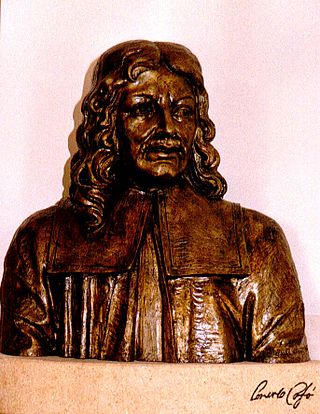
Birgu, also known by its title Città Vittoriosa, is an old fortified city on the south side of the Grand Harbour in the South Eastern Region of Malta. The city occupies a promontory of land with Fort Saint Angelo at its head and the city of Cospicua at its base. Birgu is ideally situated for safe anchorage, and over time it has developed a very long history with maritime, mercantile and military activities.

Balzan is a municipality in the Central Region of Malta, one of the so-called three villages, together with Attard and Lija. The village originally consisted of a group of small dwellings and farms but eventually grew, becoming a parish in the 17th century. As of 2021, the town registered a population of 4,774 inhabitants.

Żejtun is a city in the South Eastern Region of Malta, with a population of 11,218 at the end of 2016. Żejtun is traditionally known as Città Beland, a title conferred by the grandmaster of the Order of the Knights of Malta, Ferdinand von Hompesch zu Bolheim in 1797. Before that, the village was known as Casale Santa Caterina, named after its patron saint and parish titular.

António Manoel de Vilhena was a Portuguese nobleman who was the 66th Prince and Grand Master of the Order of St. John of Jerusalem from 19 June 1722 to his death in 1736. Unlike a number of the other Grand Masters, he was benevolent and popular with the Maltese people. Vilhena is mostly remembered for the founding of Floriana, the construction of Fort Manoel and the Manoel Theatre, and the renovation of the city of Mdina.

St John's Co-Cathedral is a Catholic co-cathedral in Valletta, Malta, dedicated to Saint John the Baptist. It was built by the Order of St. John between 1573 and 1578, having been commissioned by Grand Master Jean de la Cassière as the Conventual Church of Saint John.

Mdina, also known by its Italian epithets Città Vecchia and Città Notabile, is a fortified city in the Northern Region of Malta which served as the island's former capital, from antiquity to the medieval period. The city is still confined within its walls, and has a population of 250, but it is contiguous with the town of Rabat, which takes its name from the Arabic word for suburb, and has a population of over 11,000.

Naxxar is a town and local council in the Northern Region of Malta. The population in March 2014 was 14,891. The Naxxar Church is dedicated to Our Lady of Victories. The annual village feast is celebrated on 8 September. It formerly hosted the Maltese International Trade Fair at Maltese International Trade Fair Grounds.
Malta is the country with the most holidays in the European Union. Since 2020, any holidays falling on Saturdays or Sundays add an extra day to the workers' leave pool, reverting to the pre 2005 system.

Fra' Philippe de Villiers de L'Isle-Adam was a prominent member of the Knights Hospitaller at Rhodes and later Malta. Having risen to the position of Prior of the Langue of Auvergne, he was elected 44th Grand Master of the Order in 1521.

Maltese architecture has its origins in prehistory, and some of the oldest free-standing structures on Earth – a series of megalithic temples – can be found on Malta. The islands were colonized by the Phoenicians and later the Romans, who established the cities of Melite and Gaulos. Although these were substantial settlements and are known to have had numerous temples, churches and palaces, few remains have survived apart from some architectural fragments.

The Metropolitan Cathedral of Saint Paul, commonly known as St Paul's Cathedral or the Mdina Cathedral, is a Catholic cathedral in Mdina, Malta, dedicated to St. Paul the Apostle. The cathedral was founded in the 12th century, and according to tradition it stands on the site where Roman governor Publius met St. Paul following his shipwreck on Malta. The original cathedral was severely damaged in the 1693 Sicily earthquake, so it was dismantled and rebuilt in the Baroque style to a design of the Maltese architect Lorenzo Gafà between 1696 and 1705. The cathedral is regarded as Gafà's masterpiece.

Lorenzo Gafà (1639–1703) was a Maltese Baroque architect and sculptor. He designed many churches in the Maltese Islands, including St. Paul's Cathedral in Mdina and the Cathedral of the Assumption in Victoria, Gozo. He was the younger brother of the sculptor Melchiorre Cafà.

Tas-Samra Battery was an artillery battery in Ħamrun, Malta, built by Maltese insurgents during the French blockade of 1798–1800. It was part of a chain of batteries, redoubts and entrenchments encircling the French positions in Marsamxett and the Grand Harbour.

The Church of the Nativity of Mary is a Roman Catholic baroque parish church located in Naxxar, Malta.

The Church of the Annunciation also known as The Carmelite Church is a rich Baroque priory church of the Priory of Our Lady of Mount Carmel located in Mdina, Malta.

Wardija is a hamlet in St. Paul's Bay, Malta, about 363 feet above sea level. Its name is corrupted from the Sicilian or Italian word guardia, meaning 'to watch'). Although the name of the hamlet has Arabic lexicons, it was probably named later when Maltese, then an Arabic dialect, remained a dominant language. The hamlet is bordered by Bidnija, Buġibba, San Martin and Pwales. Several archeological remains found around the vicinity prove that it was inhabited in pre-history and the Roman period, and it has always been mainly a rural village. From the 16th till the 18th centuries it saw a shift to a hunting zone with the construction of several hunting lodges and chapels.

The Church and Monastery of St Peter is a Catholic Benedictine monastery for Cloistered nuns located in the medieval city of Mdina, Malta. The adjacent church is dedicated to St Peter and St Benedict.

St. Catherine's Old Church, also known as St. Gregory's Church, is a Roman Catholic church in Żejtun. The church and its complex sit towards the outskirts of the town, commanding views over Marsascala Bay, St. Thomas' Bay and Marsaxlokk harbour. The church is colloquially known as Saint Gregory's due to a traditional procession held on the first Wednesday following Easter Sunday. Its dedication to Catherine of Alexandria dates back to an original chapel on this site, which was one of the eight mother churches on Malta. The church stands next to the three cemeteries of Żejtun, dedicated to St. Rocco, St. Gregory and St. Catherine. The church's functions as the parish church of Żejtun were taken over by a new parish church, also dedicated to St. Catherine, and designed by Lorenzo Gafà.
Stefano Erardi (1630–1716) was a Maltese painter whose works may be found in many churches around the Maltese Islands. His style has been described as either late Mannerist or Baroque.
Pietro Paolo Troisi was a Maltese Baroque silversmith, sculptor, medallist, designer, engraver and Master of the Mint. His works include bronze sculptures of his patron António Manoel de Vilhena, designs of various coins and medals, a wide range of mainly religious works in silver, engraved portraits, designs for temporary triumphal arches and designs for works in a number of churches, most notably the altar of repose at the Mdina cathedral.



















